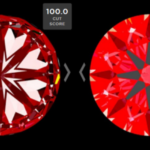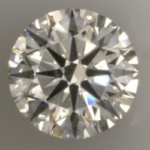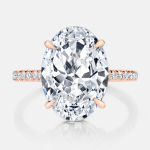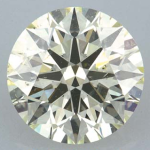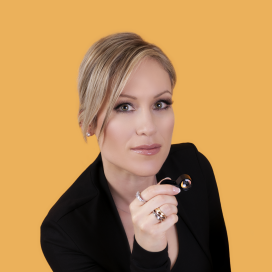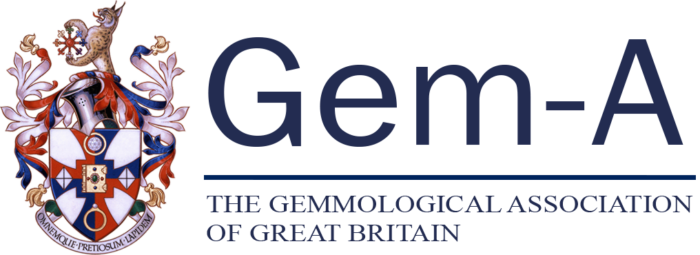Diamond carat weight is measured in carats and is not an indicator of size. The word carat is derived from the Greek word kerátion, or carob seed. It has been said that in ancient times people used the carob seed as a unit of measurement because each seed weighed consistently the same. These views have since changed, but nevertheless the name has remained. Today a one carat diamond is equal to 200 milligrams (0.2 grams) and is divided into 100 “points”. Thus a 3/4 ct diamond is 75 points or 0.75 carats.
A diamond’s carat weight is the most significant pricing determinant for diamonds. It is important to understand that as a diamond’s carat weight increases so does it’s value per carat. In fact, a diamond’s price rises exponentially with its carat weight. For example, a diamond that is double the size of another diamond can be priced up to 4x’s higher than the other diamond. Since this has long been understood by the diamond industry, many diamond cutters use this to their advantage and purposely cut diamonds to maximize their carat weight. Unfortunately, often times these diamonds are cut to poor proportions and offer less brilliance than a superior cut stone.
Popular carat sizes are usually 0.50ct, 0.75ct, 1.00ct, 1.50ct and 2.00ct. As you shop around you will notice that it is quite common to come across two different diamonds of the same carat weight but for very different prices. This is because other qualities like cut, color, clarity, and fluorescence will lower or raise the asking price of any given diamond.
Diamond Carat Weight vs. Face Up Size
Carat is a measurement of WEIGHT, not SIZE. The diameter (mm) could differ across a selection of diamonds even though the carat weight is the same. To illustrate this point take a look at the visual depiction of different proportioned 1.00ct diamonds:
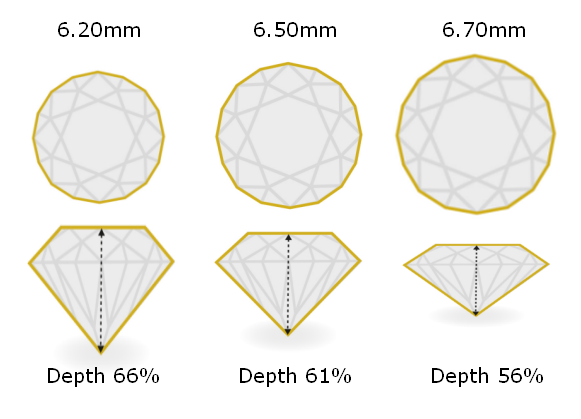
All of these diamonds are 1.00ct. However, with different depth % the face-up size will not be the same. The diamond in the middle is cut to ideal proportions and will face up true to it’s carat weight while also appearing whiter and brighter. Steep/deep and shallow cut diamonds both leak light through the pavilion and will therefore appear darker and less brilliant.
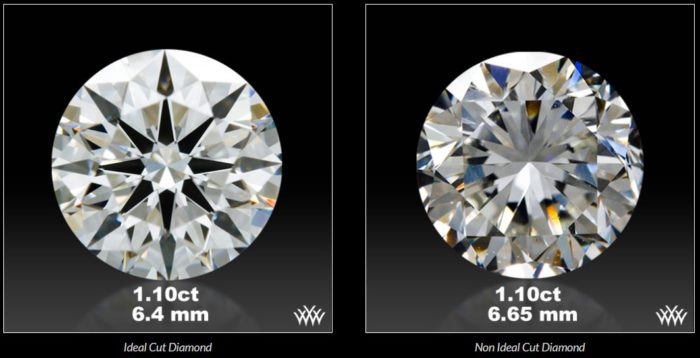
Diamond carat weight is a measure of weight and not face up size. In the above example, we can see that each diamond weighs the same but they face-up a different size in mm. This is due to how the diamond is cut. Thus carat weight is not an immediate indicator of how small or large a diamond will appear visually.
We already know that a diamond’s carat weight is the most significant pricing determinant for diamonds. The more a diamond weighs, the more it will cost. Additionally, the industry knows that consumers want to buy popular carat weights of 0.50, 0.75, 1.00, 1.50,, etc. In fact, there are large diamond cost increases once a diamond goes over this diamond carat weight threshold. Diamond cutters know this too, so it is in their best interest to keep weight on the diamond even if that means the diamond won’t have the best cut. So what can the average diamond buyer do?
Buy Shy!
Again, diamond merchants and dealers know that these are the most popular diamond carat weights. One trick to finding a less costly diamond is to find a diamond that falls just under the more popular diamond carat weight threshold (for example, look for a diamonds that are 0.90ct or 1.90ct). These diamonds will still look about the size that you had originally wanted, but you will save extra cash just because they fall short of the popular carat weights. In the industry, this is called “buying shy”.
Ideal Cut Diamonds
You already know that diamond cut is very very important. As illustrated above, a diamond’s cut proportions does affect how large the diamond will ‘face-up’. For example, if a diamond has a poor cut quality then it could be either too shallow or too deep. The latter cut can create an under-performing diamond that is visually small due to its small relative diameter. Therefore, it is best to choose an ideal or excellent cut stone to ensure that your diamond’s carat weight looks as big as you think it is.
Keep in mind that while color and clarity grades are not easily detected by the untrained eye, carat weight and diameter size is. Differences in size are clearly visible even to the untrained eye, so it is important to look into buying the best cut diamond for your budget to ensure a good face up size (diameter) as well as brilliance.
Some Important Tips To Remember:
1. Diamond carat weight is the most influential driver to a diamond’s price.
2. Diamond clarity grade is the second most influential driver to a diamond’s price.
3. Remember, a diamond’s cut is the most important “C” because it determines visual performance and sparkle. A perfectly proportioned diamond will elicit the most brilliance and light reflection.
4. A diamond’s color is a rarity characteristic with most people not being able to tell the difference between a “D” color or “H” color if looked at separately.
With these diamond facts in hand, it stands to reason that an informed consumer should look for a diamond that is: cut well, has the lowest color and clarity grade (that is still visually beautiful), and the largest diamond carat weight (that fits within your budget). Thankfully, you can do this easily by plugging in your shape, carat weight, metal setting and budget into The Diamond Genie to receive personalized diamond recommendations only for you. 🙂
ODBA Recommends
You May Also Like




